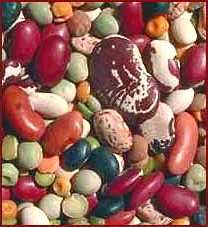
Once considered to be merely a persistent weed, amaranth is now valued both as a vegetable for its leaves and as a grain for its seeds. Long known to the Aztecs as the 'miracle grain,' it is actually not a grain but the seed of an annual herb, cousin to the tumbleweeds of the American Southwest and part of the plant family Amaranthaceae. Its name comes from the Greek 'amarantos' meaning 'one that does not wither.' Indeed, this quality has been known throughout the ages and even written about in Aesop's Fables.
Aesop's Fables: The Rose and the Amaranth
A Rose and an Amaranth blossomed side by side in a garden, and the
Amaranth said to her neighbor, "How I envy you your beauty and your
sweet scent! No wonder you are such a universal favorite." But the
Rose replied with a shade of sadness in her voice, "Ah, my dear
friend, I bloom but for a time: my petals soon wither and fall, and
then I die. But your flowers never fade, even if they are cut; for
they are everlasting."
Due to shrinking resources of the earth, there has been a growing interest in cultivation of the amaranth by indigenous people in rural areas. Prolific and easily harvested, highly tolerant of arid environments, and high in readily available protein, it is believed by many to be 'the crop of the future.'
Amaranthus species are reported to have a 30% higher protein value than cereals of rice, wheat flour, oats, and rye. Its seeds are composed of 15 to 18 percent protein including high levels of the essential amino acids lysine and methionine. When combined with grains such as wheat, rice, or barley, amaranth becomes balanced as a complete, well-absorbed protein. Its seed also contains a goodly amount of B vitamins, magnesium, manganese, copper, zinc, calcium, potassium, and iron.
There is a cautionary note to those individuals with a history of kidney stones due to calcium oxalate. A very few people diagnosed with celiac disease may experience sensitivity to amaranth because of the high oxalate levels it contains, yet for the most part amaranth is fully tolerated by those individuals as it is gluten free. It is also a suitable grain for people with Type 2 diabetes.
Additionally, the plant sterols in amaranth are proving in some studies to play a role in preventing chronic degenerative disease. Their vitamin E content also is beneficial in reducing cholesterol synthesis.
As a protein- and fiber-rich addition to the diet with a sweet, nutty flavor, amaranth can be used in the same way as grains, but it must be combined with another grain such as wheat when a rising loaf of bread is desired. That is because in order for yeast to work, gluten is needed for the bread to gain elasticity and be light and fluffy. Mix 25 percent amaranth flour with 75 percent wheat or other gluten-containing flour when making yeast breads.
Baked goods that do not require gluten such as biscuits, muffins, or pancakes can be made using 100 percent amaranth flour. Be forewarned, however, that in trying to change a recipe that calls for white flour, using amaranth as a substitute in a 1:1 ratio will likely cause the baked good to be bland in flavor and too hard.

















